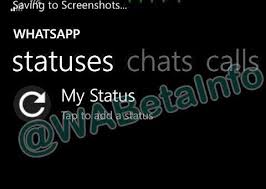 Further updates on the horizon for WhatsAppers who use Windows Phone devices. The new Beta version has just been released, and a new, hidden feature has been spotted. This latest 2.16.316.0 Beta version of WhatsApp for Windows Phone is available for Windows 10 Mobile and Windows Phone 8.1 users, and even though it seems a regular beta with just bug fixes and performance improvements, it contains a new hidden feature.
Further updates on the horizon for WhatsAppers who use Windows Phone devices. The new Beta version has just been released, and a new, hidden feature has been spotted. This latest 2.16.316.0 Beta version of WhatsApp for Windows Phone is available for Windows 10 Mobile and Windows Phone 8.1 users, and even though it seems a regular beta with just bug fixes and performance improvements, it contains a new hidden feature.
This new hidden option is the My Status feature, and those of you who are familiar with Snapchat may already know how it works. But let’s see what is it. The My Status feature simply lets users post time-limited status update images to their contact list. Furthermore, users will be enable to customize those images. But, as we said, for the moment this new My Status option is not yet officially available, so WhatsApp users will have to wait to be able to use the feature.
During the year we could notice that the life of instant messaging services in Europe has become particularly difficult, mainly for privacy issues, and apps such our beloved WhatsApp may be forced to change their policy. It seems that the European Commission intends to update its privacy rules for services such as Skype and WhatsApp, making them subject to the same European Union regulations as telephone calls and SMS text messages. At least this is what a leaked legislative draft reveals.
But what will be changed? According to Politico, a new regulation will replace the 2002 ePrivacy Directive. With the new regulation all calls made with electronic communications will be confidential, thus listening, monitoring and interfering with such calls without users’ consent will be prohibited.
According to this leaked draft: “The settings of all the components of the terminal equipment placed on the market shall be configured to, by default, prevent third parties from storing information, processing information already stored in the terminal equipment and preventing the use by third parties of the equipment’s processing capabilities.”. The draft also adds: “The use of electronic communications services by natural or legal persons for the purposes of transmitting direct marketing communications is allowed only in respect of end-users who have given their prior consent.”
